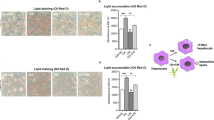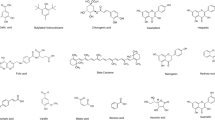Abstract
Antiproliferative effect of Amaranthus mantegazzianus proteins and peptides released after simulated gastrointestinal digestion (DH% 37.8 ± 3.8) was investigated on human colon cancer cell line HT-29. Inhibition of proliferation of HT-29 cells was exhibited after a 24 h treatment with different concentrations of amaranth protein isolate (API) and the peptides released after digestion (DGS), presenting IC50 values of 1.35 ± 0.12 and 0.30 ± 0.07 mg soluble protein/mL, respectively. Lactate dehydrogenase assay indicated that both samples caused the loss of membrane integrity and cell lysis over HT-29 cells, and DAPI fluorescence microscopies evidenced typical apoptotic features. Moreover, Annexin V-FITC flow cytometry showed a significant increase of early apoptotic and late apoptotic/necrotic HT-29 cells compared to untreated ones, and caspase-3 assay confirmed the apoptosis induction with a 43.0 ± 10.3 and 65.8 ± 12.7% increase of caspase-3 activity produced by a 2 mg/mL treatment of API and DGS, respectively. In conclusion, amaranth peptides successfully released after simulated gastrointestinal digestion would exert a potential antiproliferative activity over HT-29 tumor cells. This effect was linked to the induction of cell necrosis and apoptosis, supporting the idea of using amaranth proteins as a potential food alternative ingredient for functional foods.





Similar content being viewed by others
Abbreviations
- DGS:
-
Amaranth peptides released after simulated gastrointestinal digestion
- API:
-
Amaranth protein isolate
- DH%:
-
Degree of hydrolysis
- LDH:
-
Lactate dehydrogenase
- DAPI:
-
2-(4-Amidinophenyl)-6-indolecarbamidinedihydrochloride, 4′,6-diamidino-2-phenylindole dihydrochloride
References
World Health Organization (WHO) Global Initiative for Cancer Registry Development. Press Release N° 263. http://gco.iarc.fr/. Accessed 12 Sept 2018
Ferlay J, Soerjomataram I, Dikshit R, Eser S, Mathers C, Rebelo M, Parkin DM, Forman D, Bray F (2015) Cancer incidence and mortality worldwide: sources, methods and major patterns in GLOBOCAN 2012. Int J Cancer 136:E359–E386. https://doi.org/10.1002/ijc.29210
Balmain A, Barrett JC, Moses H, Renan MJ (1993) How many mutations are required for tumorigenesis? Implications from human cancer data. Mol Carcinog 7:139–146. https://doi.org/10.1002/mc.2940070303
Kris-Etherton PM, Hecker KD, Bonanome A et al (2002) Bioactive compounds in foods: their role in the prevention of cardiovascular disease and cancer. Am J Med 113:71S–88S
Aphalo P, Martínez EN, Añón MC (2015) Amaranth sprouts: a potential health promoting and nutritive natural food. Int J Food Prop 18:2688–2698. https://doi.org/10.1080/10942912.2015.1004585
Delgado MCO, Galleano M, Añón MC, Tironi VA (2015) Amaranth peptides from simulated gastrointestinal digestion: antioxidant activity against reactive species. Plant Foods Hum Nutr 70:27–34. https://doi.org/10.1007/s11130-014-0457-2
Sabbione AC, Nardo AE, Añón MC, Scilingo A (2016) Amaranth peptides with antithrombotic activity released by simulated gastrointestinal digestion. J Funct Foods 20:204–214. https://doi.org/10.1016/j.jff.2015.10.015
Moronta J, Smaldini PL, Docena GH, Añón MC (2016) Peptides of amaranth were targeted as containing sequences with potential anti-inflammatory properties. J Funct Foods 21:463–473. https://doi.org/10.1016/j.jff.2015.12.022
Bressani R (1994) Composition and nutritional properties of amaranth. In: Paredes-López O (ed) Amaranth: biology, chemistry, and technology. CRC Press, Boca Ratón, pp 185–206
Hernández-Ledesma B, Hsieh C-C, de Lumen BO (2009) Lunasin, a novel seed peptide for cancer prevention. Peptides 30:426–430. https://doi.org/10.1016/j.peptides.2008.11.002
Sah BNP, Vasiljevic T, Mckechnie S, Donkor ON (2015) Identification of anticancer peptides from bovine milk proteins and their potential roles in management of cancer: a critical review. Compr Rev Food Sci Food Saf 14:123–138. https://doi.org/10.1111/1541-4337.12126
Barrio DA, Añón MC (2010) Potential antitumor properties of a protein isolate obtained from the seeds of Amaranthus mantegazzianus. Eur J Nutr 49:73–82. https://doi.org/10.1007/s00394-009-0051-9
Quiroga AV, Barrio DA, Añón MC (2015) Amaranth lectin presents potential antitumor properties. LWT-Food Sci Technol 60:478–485. https://doi.org/10.1016/j.lwt.2014.07.035
Barba de la Rosa AP, Silva-Sánchez C, González de Mejia E (2006) Amaranth: an ancient crop for modern technology. In: Tunick MH, González de Mejía E (eds) Hispanic foods: chemistry and flavor. ACS Symposium Series, Washington DC, pp 103–116
Martínez EN, Añón MC (1996) Composition and structural characterization of amaranth protein isolates. An electrophoretic and calorimetric study. J Agric Food Chem 44:2523–2530. https://doi.org/10.1021/jf960169p
Hernandez-Ledesma B, Amigo L, Ramos M, Recio I (2004) Angiotensin converting enzyme inhibitory activity in commercial fermented products. Formation of peptides under simulated gastrointestinal digestion. J Agric Food Chem 52:1504–1510. https://doi.org/10.1021/jf034997b
Roesler KR, Rao AG (2001) Rapid gastric fluid digestion and biochemical characterization of engineered proteins enriched in essential amino acids. J Agric Food Chem 49:3443–3451. https://doi.org/10.1021/jf010209b
Markwell MAK, Haas SM, Bieber LL, Tolbert NE (1978) A modification of the Lowry procedure to simplify protein determination in membrane and lipoprotein samples. Anal Biochem 87:206–210. https://doi.org/10.1016/0003-2697(78)90586-9
Peterson GL (1977) A simplification of the protein assay method of Lowry et al. which is more generally applicable. Anal Biochem 83:346–356. https://doi.org/10.1016/0003-2697(77)90043-4
Nkonge C, Ballance GM (1982) A sensitive colorimetric procedure for nitrogen determination in micro-Kjeldahl digests. J Agric Food Chem 30:416–420. https://doi.org/10.1021/jf00111a002
Yemm EW, Willis AJ (1954) The estimation of carbohydrates in plant extracts by anthrone. Biochem J 57:508–514. https://doi.org/10.1042/bj0570508
AOAC (1990) AOAC Official Methods of Analysis. Assoc Off Agric Chem Gaithersburg, USA 16th:
Nielsen PM, Petersen D, Dambmann C (2001) Improved method for determining food protein degree of hydrolysis. J Food Sci 66:642–646. https://doi.org/10.1111/j.1365-2621.2001.tb04614.x
Sabbione AC, Scilingo A, Añón MC (2015) Potential antithrombotic activity detected in amaranth proteins and its hydrolysates. LWT-Food Sci Technol 60:171–177. https://doi.org/10.1016/j.lwt.2014.07.015
Schägger H (2006) Tricine-SDS-PAGE. Nat Protoc 1:16–22. https://doi.org/10.1038/nprot.2006.4
Köhler C, Orrenius S, Zhivotovsky B (2002) Evaluation of caspase activity in apoptotic cells. J Immunol Methods 265:97–110. https://doi.org/10.1016/S0022-1759(02)00073-X
Segura-Nieto M, Barba de la Rosa A, Paredes-López O (1994) Biochemistry of amaranth proteins. In: Paredes-López O (ed) Amaranth: biology, chemistry and technology. CRC Press, Boca Ratón, pp 129–185
Quiroga A, Martínez EN, Rogniaux H et al (2010) Amaranth (Amaranthus hypochondriacus ) vicilin subunit structure. J Agric Food Chem 58:12957–12963. https://doi.org/10.1021/jf103296n
Vilcacundo R, Miralles B, Carrillo W, Hernández-Ledesma B (2018) In vitro chemopreventive properties of peptides released from quinoa (Chenopodium quinoa Willd.) protein under simulated gastrointestinal digestion. Food Res Int 105:403–411. https://doi.org/10.1016/j.foodres.2017.11.036
Vilcacundo R, Martínez-Villaluenga C, Miralles B, Hernández-Ledesma B (2018) Release of multifunctional peptides from kiwicha (Amaranthus caudatus) protein under in vitro gastrointestinal digestion. J Sci Food Agric. https://doi.org/10.1002/jsfa.9294
Bajbouj K, Schulze-Luehrmann J, Diermeier S, Amin A, Schneider-Stock R (2012) The anticancer effect of saffron in two p53 isogenic colorectal cancer cell lines. BMC Complement Altern Med 12:69–77. https://doi.org/10.1186/1472-6882-12-69
Porter AG, Jänicke RU (1999) Emerging roles of caspase-3 in apoptosis. Cell Death Differ 6:99–104. https://doi.org/10.1038/sj.cdd.4400476
Dia VP, Gonzalez de Mejia E (2010) Lunasin promotes apoptosis in human colon cancer cells by mitochondrial pathway activation and induction of nuclear clusterin expression. Cancer Lett 295:44–53. https://doi.org/10.1016/j.canlet.2010.02.010
Maldonado-Cervantes E, Jeong HJ, León-Galván F, Barrera-Pacheco A, de León-Rodríguez A, González de Mejia E, de Lumen BO, Barba de la Rosa AP (2010) Amaranth lunasin-like peptide internalizes into the cell nucleus and inhibits chemical carcinogen-induced transformation of NIH-3T3 cells. Peptides 31:1635–1642. https://doi.org/10.1016/j.peptides.2010.06.014
Silva-Sánchez C, de la Rosa APB, León-Galván MF, de Lumen BO, de León-Rodríguez A, de Mejía EG (2008) Bioactive peptides in Amaranth (Amaranthus hypochondriacus) seed. J Agric Food Chem 56:1233–1240. https://doi.org/10.1021/jf072911z
Acknowledgments
Authors are very grateful for the contribution of the researcher Dr. Hongnan Sun.
Funding
This work was supported by International PICT “Vegetable proteins as a source of functional and healthy ingredients” under China-Argentina Binational Center in Food Science and Chinese Ministry of Science and Technology (No. KY201401005).
Author information
Authors and Affiliations
Corresponding authors
Ethics declarations
Conflict of Interest
Authors Ana Clara Sabbione, Fredrick Onyango Ogutu, Adriana Scilingo, Zhang Miao, María Cristina Añón and Tai-Hua Mu, declare that they have no conflict of interest.
Additional information
Publisher’s Note
Springer Nature remains neutral with regard to jurisdictional claims in published maps and institutional affiliations.
Rights and permissions
About this article
Cite this article
Sabbione, A.C., Ogutu, F.O., Scilingo, A. et al. Antiproliferative Effect of Amaranth Proteins and Peptides on HT-29 Human Colon Tumor Cell Line. Plant Foods Hum Nutr 74, 107–114 (2019). https://doi.org/10.1007/s11130-018-0708-8
Published:
Issue Date:
DOI: https://doi.org/10.1007/s11130-018-0708-8




